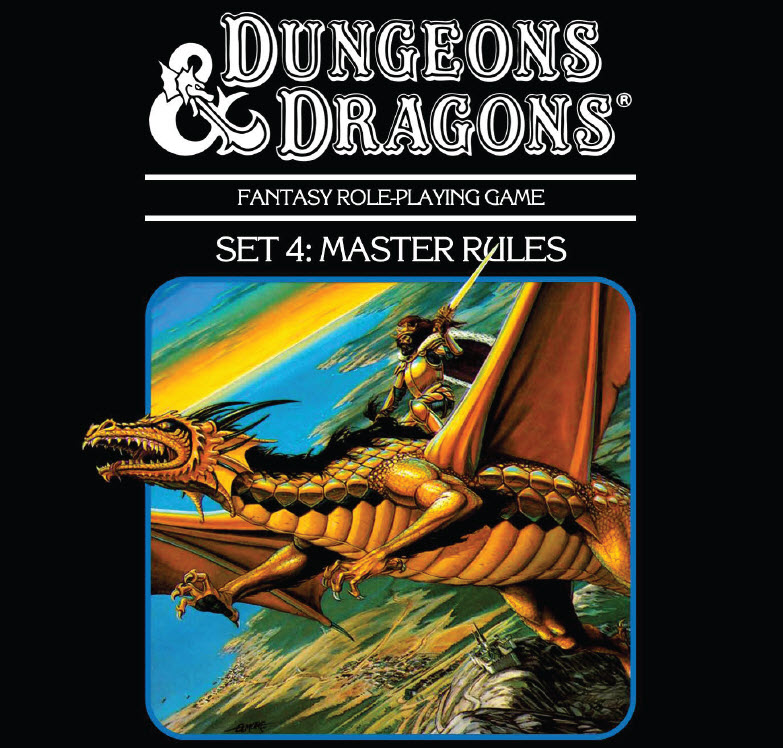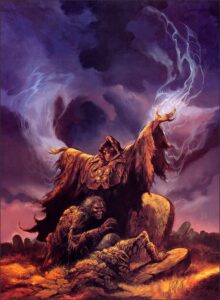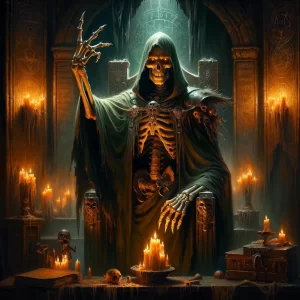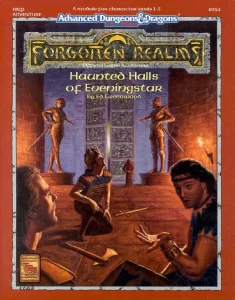
The Dungeons & Dragons Master Rules Box Set #4, published in 1985, stands as a remarkable expansion in the D&D Basic Set series. This set is a culmination of everything that had come before it, pushing the boundaries of what the game could offer. Designed to cover gameplay from levels 26 to 36, the Master Rules invited players into a realm of high adventure, where their characters had not only survived the perils of dungeons and wilderness but had risen to the heights of power, often becoming legendary figures in their own right.
By the time players reached the levels outlined in the Master Rules, they had already trekked through the Basic, Expert, and Companion sets, building up their characters' stories and skills. While earlier sets focused on exploring the unknown and building personal wealth and power, the Master Rules took the game into new territories of gameplay, diving deep into the mechanics of running kingdoms, engaging in mass combat, and exploring the path to immortality. This expansion set wasn't just about bigger monsters or more gold; it was about the characters transitioning from adventurers to rulers and even to demigods.
Rules Expansion and Advanced Gameplay
The Master Rules opened with revisions and additions to the rules found in the earlier sets, expanding on spells, combat, and character abilities. One of the most significant aspects of this set was the inclusion of even higher-level spells and abilities. For magic-users, new spells up to the 9th level became available, introducing powerful effects that could shape entire regions. Spells like Meteor Swarm or Wish allowed wizards to wield powers that approached the god-like, altering the fabric of the game world itself.
The set also provided detailed rules on the intricacies of high-level combat. Combat mechanics in previous sets were streamlined to handle encounters with relatively fewer combatants. However, at the higher levels detailed in the Master Rules, adventurers could find themselves facing dragons, armies, and extraplanar beings. As such, this set introduced more complex combat rules that allowed for mass battles, intricate magical duels, and the management of large-scale conflicts. New rules for siege warfare and domain defense were introduced, giving players the ability to not only conquer new territories but also defend their holdings against rival factions and monstrous threats.
Beyond Adventuring: Domains, Rulership, and Immortality
One of the most revolutionary additions to the game was the concept of rulership. By the time characters reached levels 26 and beyond, they had often accumulated significant wealth and influence. The Master Rules provided a framework for managing domains, outlining rules for taxes, managing armies, and dealing with political intrigue. Characters could now become kings, queens, archmages ruling magical schools, or high priests of vast religious orders. This new layer of gameplay transformed D&D from mere dungeon crawling into a fully-fledged fantasy simulation, where players could explore the dynamics of leadership and governance.
Rulership wasn't merely about collecting taxes or building castles; it introduced challenges like revolts, economic crises, and diplomatic negotiations with other rulers. This opened up an entirely new avenue of storytelling, where players' decisions shaped not just the fate of their characters, but entire regions. High-level play now required not only martial might or magical power but also political savvy and strategy.
The most fascinating aspect of the Master Rules was its treatment of immortality. By this stage, characters had the option to pursue a path toward becoming immortal. This wasn't simply about achieving a state of undying existence but involved undertaking epic quests and trials set by the Immortals of the D&D multiverse. Characters had to prove their worthiness, whether through feats of heroism, demonstrations of arcane mastery, or profound wisdom. These quests could span multiple adventures, becoming a grand narrative in themselves. The journey to immortality often involved dealings with gods, celestial beings, and forces of the multiverse, bringing the game to an epic scale rarely seen in previous levels of play.
Behind the Scenes
The Master Rules box set was the brainchild of Frank Mentzer, a prolific D&D designer, and writer. His work on the Basic Set series is legendary, as he sought to create a comprehensive framework that could guide players from their first dungeon crawl to the pinnacle of power. The Master Rules was the fourth installment in a five-part series that ended with the Immortal Rules, which allowed players to take on god-like roles in the game world.
A little-known fact about the Master Rules is that it marked one of the first instances where D&D explicitly dealt with the concept of a "soft cap" on character progression. While the rules covered levels up to 36, they hinted at the idea that characters could continue to grow in power, albeit in ways that went beyond numerical advancement. This idea was a precursor to the concept of "epic levels" that would later be explored in subsequent editions of D&D.
Additionally, the box set itself was a product of its time. The artwork and design drew heavily from the sword-and-sorcery aesthetic popular in the 1980s, with illustrations that depicted epic battles, towering castles, and characters wielding tremendous magical power. The interior art and maps fueled the imaginations of Dungeon Masters and players alike, serving as inspiration for the kinds of adventures that the Master Rules encouraged.
One fascinating piece of trivia revolves around the spells introduced in this set. Some of the new high-level spells, such as Meteor Swarm, went on to become staples in future editions of D&D. The detailed descriptions of these spells in the Master Rules laid the groundwork for how magic would be portrayed in the game for decades to come. Similarly, the rules for mass combat and domain management influenced the development of later D&D products, including supplements like the Rules Cyclopedia and the Birthright campaign setting in the Advanced Dungeons & Dragons line.
Cultural Impact and Legacy
While not as widely recognized today as some of the other D&D rule sets, the Master Rules were instrumental in shaping the concept of high-level play. The idea that characters could ascend beyond mortal limitations, rule vast domains, and contend with cosmic forces resonated with players who sought a game experience that went beyond dungeon delving. The rules for domain management and mass combat were forerunners to many modern tabletop RPG mechanics that deal with territory control, kingdom building, and large-scale strategy.
The Master Rules also emphasized storytelling at a grander scale. It pushed DMs and players to think not just in terms of immediate encounters but in terms of overarching narratives that spanned continents and decades. This broadened the scope of D&D campaigns, showing that the game could support stories of legendary proportions.
Today, the Master Rules may be seen by some as a classic relic of the game's history. Collectors often seek out the box set as a piece of D&D's golden era. Its emphasis on epic fantasy and grand strategy continues to inspire modern gaming, serving as a testament to the imaginative possibilities that the world of Dungeons & Dragons offers.






